Miracle Harbor |
Published May, 1945, by
BRITISH INFORMATION SERVICES
(An Agency of the British Government)
ROCKEFELLER PLAZA · NEW YORK 20, N.Y.
Miracle Harbor
Published May, 1945, by
BRITISH INFORMATION SERVICES
(An Agency of the British Government)
ROCKEFELLER PLAZA · NEW YORK 20, N.Y.
AMERICAN and British officers planning the D-Day details in England were up against a tremendous problem. It was all very well to land troops on the beaches of Normandy, but once there they had to be kept supplied with immense quantities of ammunition, food, and weapons. How were these supplies to keep flowing without a harbor? "We'll take our harbors with us."
There was a limit to what landing craft could do. The rough Channel seas and the tide that rises and falls twenty feet meant that stuff put down on the flat Normandy beaches would be swamped by the tide before it could all be moved onto dry land. And the idea of starting off the invasion by capturing one of the heavily defended French ports was out of the question. It would take too long.
The story goes that one of the officers engaged in the planning remarked casually to one of his colleagues, not intending to be taken seriously, "Well, I suppose we'll have to take our harbors with us." This remark, it is reported, started the experts on a train of thought that ended at the point where the ramps of the prefabricated ports touched the Normandy shore.
Whether this is the true story of the origin of "Operation MULBERRIES" is not known, but at all events the idea, fostered by Winston Churchill, was presented at the Quebec Conference of August, 1943, and the decision was made there that the Allies would build two harbors as big as Dover and take them along to France.Then began in Britain one of the most colossal and original engineering projects of this war. Detailed plans were worked out by the British Admiralty and the War Office, and 20,000 British workers were assigned to building the parts at various points in England.
On D-Day a huge fleet of several nationalities, besides British and American, began to tow the ports across the English Channel to pre-arranged sites on the French shore, escorted by the British Navy. On arrival, American Seabees, British Sailors and British Army Engineers assembled them. One harbor was wrecked in a severe gale, but nevertheless in the first 109 days of the invasion the Allies put ashore 2,500,000 troops, more than half a million vehicles, and 17,000,000 ship tons of munitions, weapons and supplies--a task that could not possibly have been achieved without the portable harbors.
In this pamphlet is shown briefly how these harbors were constructed and put to use.
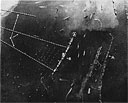
1. The prefabricated harbor consisted of three main elements. The breakwater (A) was made of a chain of great concrete caissons and blockships, sunk to form a shelter for the cargo ships as they dock at the pierheads (B) where they unload. The cargoes are carried on vehicles along the floating roadways (C) that run from the pierheads to the shore-ramps onto the land. (Note in picture above that the sea is rougher outside the caissons. Note also the barrage balloons above the caissons.
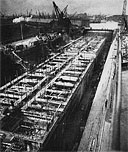
2. The parts of the "MULBERRY" harbors were all built in Britain. The job kept 20,000 British workers working at top speed; 865,000 tons of reinforced concrete had to be cast in six months. Above are shown some caissons under construction in British yards.

3. The parts were towed 100 miles across the stormy English Channel by tugs, protected by the Royal Navy. Here is seen one of the 150 concrete caissons which formed the main breakwaters, being towed.
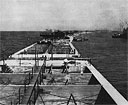
4. The caissons were placed in a continuous row. They were built in six different sizes for different depths of water. The biggest displaced 6,044 tons, the smallest 1,672 tons. Note the sea-cocks used to let in the water to sink them in position. Dredge ships also pumped sand into the compartments. For protection against enemy air attack anti-aircraft guns were mounted on the biggest caissons and barrage balloons floated overhead. Quarters for the A-A gun crews were built on the caissons.
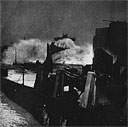
5. To supplement the caissons, sixty old Allied warships and merchant ships sailed under their own steam and were scuttled to form part of the breakwater. One of them was the old British warship, H.M.S. Centurion, shown above.

6. The wharf for unloading the ships inside the breakwater was made of floating pierheads. Above, one of them is seen waiting to be towed into position. The pillars at the corners are adjustable legs, lowered according to the depth of the water, to anchor the pierhead to the sea bed.
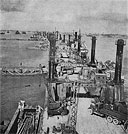
7. Here is seen a row of seven pierheads, joined together by bridges to form the wharf. Note the markings on the legs indicating the depth of the water.
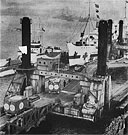
8. The pierhead in action. Wounded are being transferred from the ambulances to a hospital ship for return to England.
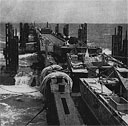
9. Extending from the pierheads to the shore were seven miles of floating roadways, over which the trucks carried the cargo into France. A section of them, 480 feet long, is shown above being towed across the English Channel.
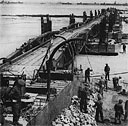
10. Here are seen men of the Royal Engineers putting the finishing touches to the ramp on the Normandy end of the floating roadway. The job of assembling the harbor for U.S. supplies was done by the American Seabees.
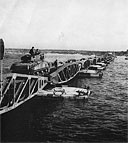
11. The floating roadway is completed, and a tank starts across.0
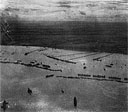
12. Here is a general view of the "MULBERRY" harbor completed and in full operation. In front is the breakwater of caissons and blockships; to the center is the row of pierheads forming the wharf, and running from them to the shore are the floating roadways. All together they form a port about as big as Dover.
British Information Services offer the public: An Enquiries Service; as Reference Library; Exhibitions and Films; free Booklets, Posters, Information Papers.See A Harbor Goes to France, A British Ministry of Information film, when it comes to your local cinema soon.

All photos are British Official except item 5 which is an Official U.S. Coast Guard photo.